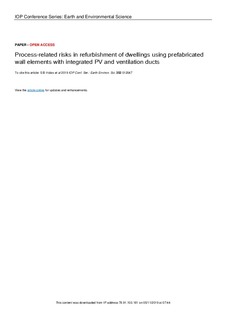| dc.description.abstract | Prefabricated façade elements with integrated technical infrastructure is an attractive technology for refurbishment of existing dwellings. Heating and cooling demand can be reduced, local energy production introduced, and indoor air quality be improved, with disturbance to the tenants and building site being small and of short duration compared to more traditional building processes. On the other hand, unexpected events could largely reduce these benefits. Thus, risk management of the building process is of great importance. Focus group interviews and workshops were arranged before and after the building phase in a pilot project using such elements in Oslo, Norway. Representatives of building owner, design team and contractor contributed actively at the workshop. In a pre-building phase workshop, a range of hazards were identified and prioritized using a participative process facilitated by a neutral moderator. A large proportion of the prioritized risks in the building phase were connected to the renovated flats being occupied during the renovation. Other significant identified risks related to transport and logistics, and undetected challenges in the existing construction. Mitigation included prioritizing tenant information, including direct dialog, and increasing the presence of on-site workforce both for coordination with tenants and in order to respond quickly to unforeseen events. The participants emphasized that an open, cooperative processes with a high degree of trust and sense of a common goal had been important for the robust design that was developed prior to the workshop. During the retrospective evaluation, the participants concluded that the risk mitigation procedures had been successful in preventing some events as well as reducing the consequences of others. However, some of the measures to mitigate an identified risk of rain intrusion were inadequate, and it was acknowledged that the combination of bad weather and long working days could have identified this as preventable. | nb_NO |

